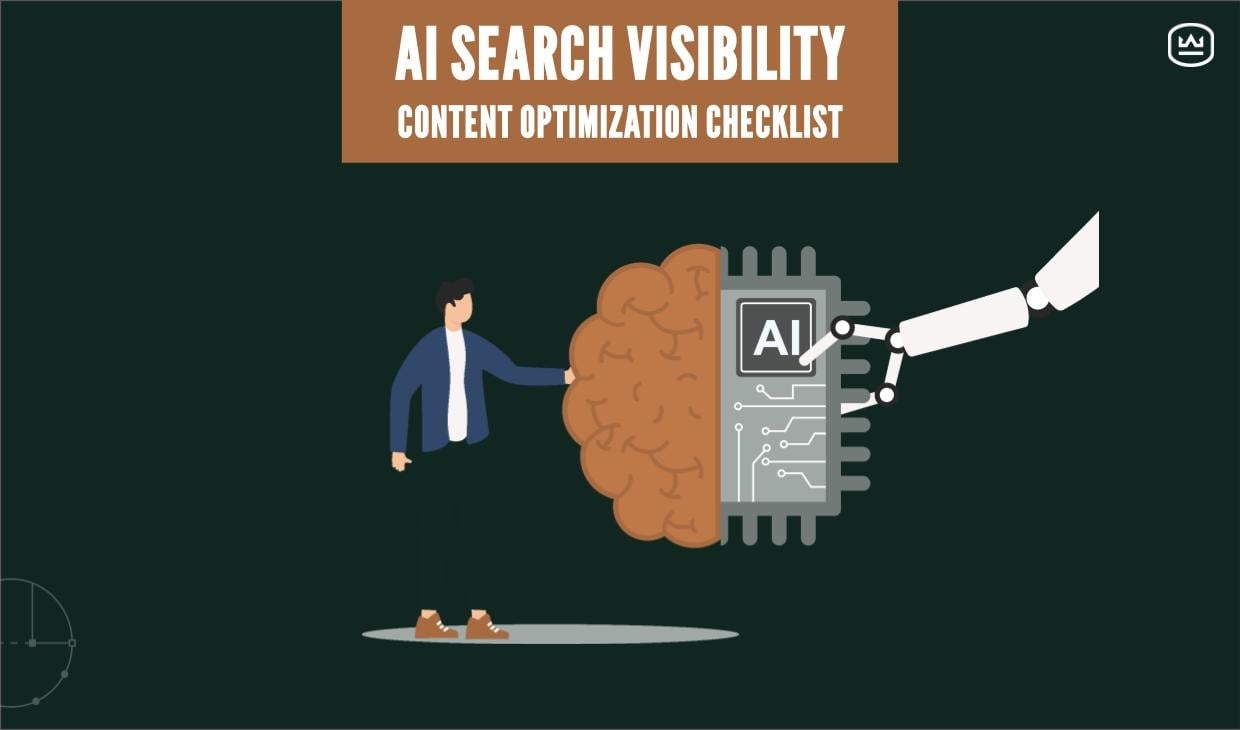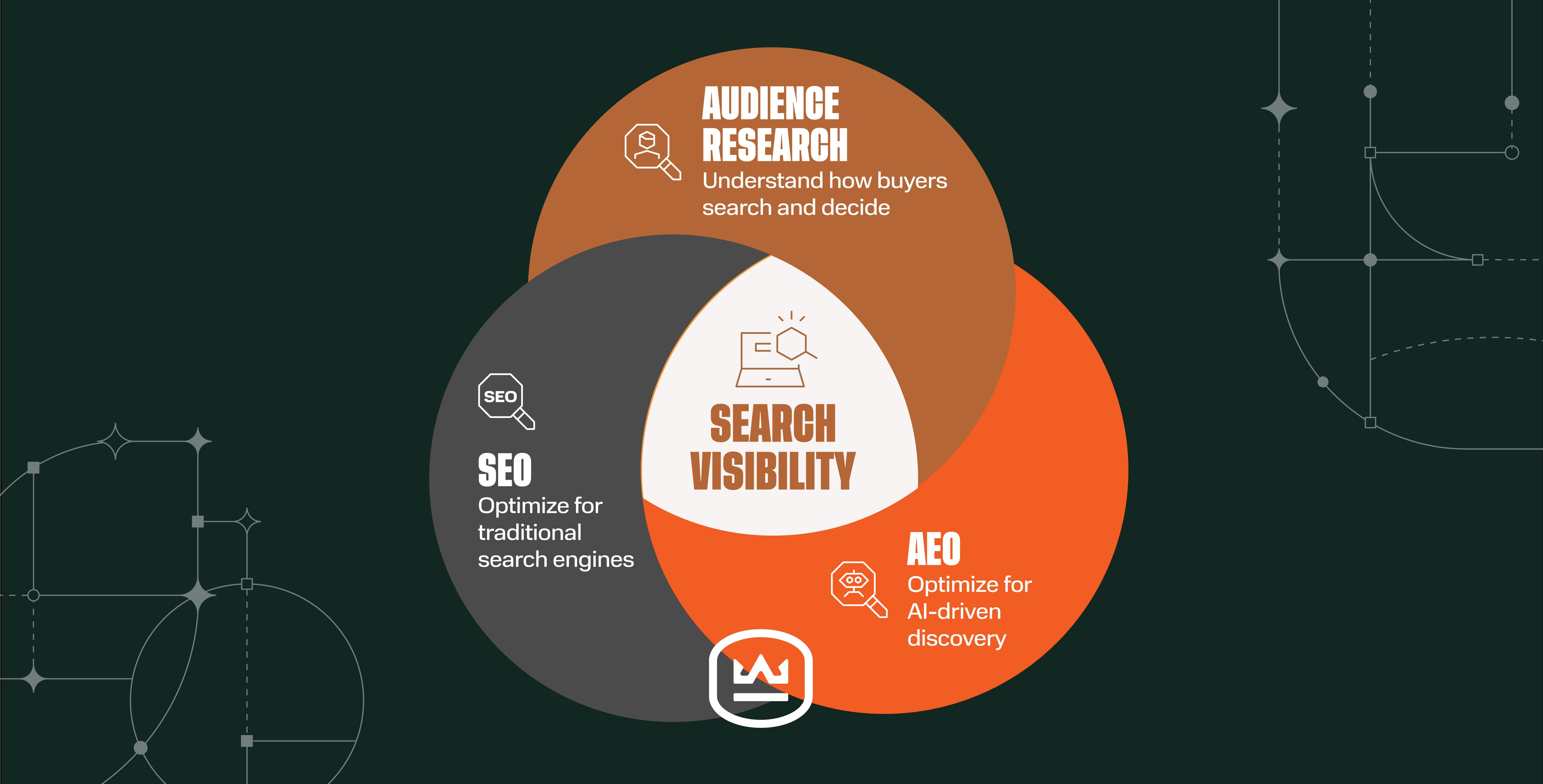The Content Evolution: Andy Crestodina on AI, Analytics, and Strategy
Written by
In Part 1 of my conversation with Andy Crestodina on The ChangeOver Podcast, we explored strategic content allocation, the evolution of blogging, and how to create high-value content with limited resources.
In part two, Andy shares tactical insights on adapting to AI’s impact on search, leveraging analytics in decision-making, and creating more effective content through smart experimentation.
As AI fundamentally changes the ways people access information, industrial marketers face new challenges in measuring effectiveness and demonstrating ROI. Andy’s pragmatic approach focuses on strategic restraint, rigorous measurement, and continual experimentation to provide a framework for content marketers looking to win the long game.
I recommend listening to the full episode to hear directly from Andy as he breaks down complex topics with his characteristic clarity. Pressed for time? Skim the blog to whet your appetite, and come back to the full podcast for a deeper dive.
Check out episode 20 of The ChangeOver now, then subscribe on Apple, YouTube, Spotify, Weidert.com, or your favorite podcast app.
Your New Website Visitors Aren’t Human
Perhaps the most mind-bending aspect of our conversation centered on what Andy referred to as “non-human users” — AI agents and bots that now visit your website alongside human visitors:
There are two types of AI visitors to your website. One is a bot that’s visited many times, just like Google bots do. It’s trying to understand what you do. The other is the AI agent that clicks around, reports back to its human user, can fill out your forms. It’s going to get weird.
When a prospect asks an AI assistant to research companies, their AI doesn’t simply Google — it visits websites, clicks through navigation, digests content, and compiles data. Unlike human visitors, AI doesn’t get tired or lose patience — it reads everything. This creates new “AI accessibility” considerations that demand websites with exceptional clarity.
But there’s a potentially alarming problem looming for data-driven marketers: AI doesn't show up in your analytics. They don't accept cookies. At the same time, privacy laws don't apply to this type of visitor — and very smart people are hard at work figuring a way around the problem.
How to optimize your website for non-human users:
- Prioritize clarity over aesthetics: Ensure your website communicates what you do, who you serve, and how you solve problems with absolute clarity.
- Enhance your structured data: Implement comprehensive schema markup to make your key business information machine-readable.
- Create a GA4 exploration for AI traffic: “First thing you need to do is to go to GA4 and create a report. It’s called an exploration that shows traffic from AI to your website. It’s the fastest growing traffic to your website.”
- Answer all potential questions: “You need a site that answers all the questions because the agentic AI doesn't get tired or lose patience. It will read every word.”
Focus on informational completeness: Include detailed specifications, pricing information, service areas, and other key decision factors.
Optimizing Content to Appear in AI Recommendations
To position your brand for AI recommendation, Andy suggests focusing on distribution and promotion strategies that achieve widespread brand mentions, to increase the appearance of your brand within AI training data (i.e., the internet) alongside the phrases you want to be associated with. He emphasizes that getting recommended by AI systems will be a critical move for businesses in 2025 and beyond. His specific advice:
Probably, a bunch of our content should be on other people’s websites. Guest posts, press releases, a pitch, be present in roundups... webinars, live events. And then, when you have the chance in that context, make sure that you give the tiny elevator pitch for your business because that’s what we’re injecting into the training data.
The Data Opacity Crisis
We’re entering a new period of what you might call a “data opacity crisis,” where clean attribution models are disintegrating. While it’s muddying the waters, it’s worth asking how dependable attribution models have been in the first place.
This takes us back to marketing in the 1990s or 80s or 70s when you do the things, but you don’t ever hope to connect it straight line. It was a weird era we were in when you could sort of get attribution on things like clicks, and that specific action led to the specific outcome. That’s becoming much more difficult now.
The multi-channel, AI-mediated customer journey is rendering traditional analytics increasingly inadequate. But that doesn't mean measurement is dead — it means we need to dig deeper:
If you don't click two or three times on an analytics report, it's not a good analytics report. You have to keep clicking on it, make a filter or create a secondary dimension, customize the report or create comparisons.
How to adapt your analytics approach:
- Stop focusing on top-line metrics: Never report on top line traffic alone. Drill down traffic from search to key pages.
- Create customized reports: “If you don’t click two or three times on an analytics report, it’s not a good report. You have to keep clicking on it, make a filter or create a secondary dimension, customize the report or create comparisons.”
- Look for patterns, not just direct attribution: Correlate changes in traffic to specific pages with sales activity.
- Exclude irrelevant traffic: Consider filtering out those two or three random blogs that drive lots of traffic but have little to no business impact.
Focus on what matters most: Ask yourself what phrases still have “visit-website” intent — before you create a piece of content.
Advanced AI Applications: From Audits to Synthetic Personas
While many marketers already use AI for content creation, Andy highlighted more sophisticated applications for marketing impact, like mini audits, content gap analysis, and synthetic persona creation using custom GPTs:
Imagine. The end result will be that you have a synthetic member of your target audience that you can talk to day or night. You can get feedback on any asset.
To build AI personas that add value to your program, Andy recommended focusing on five key elements:
- Build comprehensive persona documents: Include hopes and dreams, fears and concerns, emotional triggers, decision criteria, and objections.
- Upload supporting materials: “You can upload to AI. I’ve got an ideal client persona profile, or I’ve got some interview notes from my last 10 meetings, you know — or the SparkToro reports.”
- Validate and refine: Remember, AI will miss something. You’re still the expert, and accountable for the accuracy of your personas.
- Use for asset review: Ask for feedback on your marketing strategy, on assets, on trusted channels for distribution.
- Create targeted audit prompts: Here’s an example from Andy, “Rate the extent to which this [content piece] meets or does not meet the information needs of the persona, or aligns or does not align with the emotions of the persona.”
Paid Advertising: Strategic Resource Allocation
When it comes to paid promotion, Andy advocates for a selective approach based on conversion data:
If you have a page in Google Analytics, like one of your sales pages, that’s got like a three or four or 5% conversion rate — yeah, let’s buy some visitors to that, because when you’ve found your best mousetrap, put some cheese on that baby.
Rather than spreading your budget across multiple campaigns, concentrate on pages with proven conversion performance.
The Stakeholder Persuasion Game
In discussing how to secure buy-in from stakeholders, Andy revealed an underused strategy — applying marketing principles to internal audiences:
Use FOMO to get approval from your executives by showing them that your competitors are pretty strong in these categories. Social proof is one of the most powerful levers for triggering visitor behavior. It's also a very powerful lever for triggering stakeholder buy-in behavior… Use your marketing skills. Bring data, bring evidence, and trigger biases — it works.
This approach recognizes that securing resources is fundamentally a persuasion challenge — one that requires the same strategic thinking we apply to external marketing:
- Use competitive analysis: Show them when competitors are achieving lots of awareness in these channels
- Lead with prioritization: Start with what’s most impactful for sales, and prioritize what connects closely to revenue
- Frame content initiatives as finite projects: Executives don’t like approving budgets for infinite programs — so put down some boundaries and provide some certainty where you can
Final Thoughts: Embracing the New Reality
The emerging marketing landscape is simultaneously more complex (with non-human users and diminished data visibility) and more focused (with strategic resource allocation and prioritization of high-value content).
So, who wins in this environment? Marketers who:
- Optimize their websites for both human and non-human visitors
- Focus content resources on revenue-proximate activities
- Create distinctive content that AI can’t replicate
- Measure what matters, not just what’s visible
- Apply marketing principles to internal stakeholder management
This focus on fundamentals, augmented by sophisticated understanding of emerging technologies, may be the most future-proof strategy of all.
For more insights like these, join us at Experience Inbound on May 19 at Lambeau Field in Green Bay or May 20 at the Harley-Davidson Museum in Milwaukee.
Be sure to check out Andy’s book, Content Chemistry: The Illustrated Handbook for Content Marketing — the seventh edition has been updated to address many of the challenges we’ve discussed on the podcast, including example AI prompts.
And if you missed part one of this series, where we discussed strategic content allocation and the new blogging paradigm, you can find it here: Revenue-Driving B2B Content Marketing Strategy with Andy Crestodina.
Subscribe To Our Blog
Information. Insights. Ideas. Get notified every time a new Weidert Group blog article is published – subscribe now!
You May Also Like...

Search Engine Optimization
How Falcon Rebuilt Industrial AI Search Visibility in 2025

Search Engine Optimization
The New Search Visibility Checklist for AI-Era Content Marketing

Search Engine Optimization
SEO Isn’t Dead. It’s Evolving: How B2Bs Can Stay Visible in the Age of AI
Accelerate Your Growth with
Weidert Group
If you’re ready to explore a partnership, request a personalized consultation with our team.

